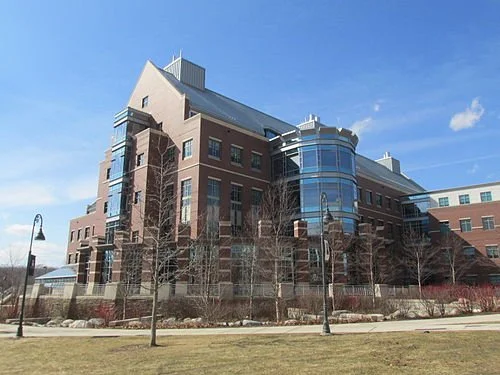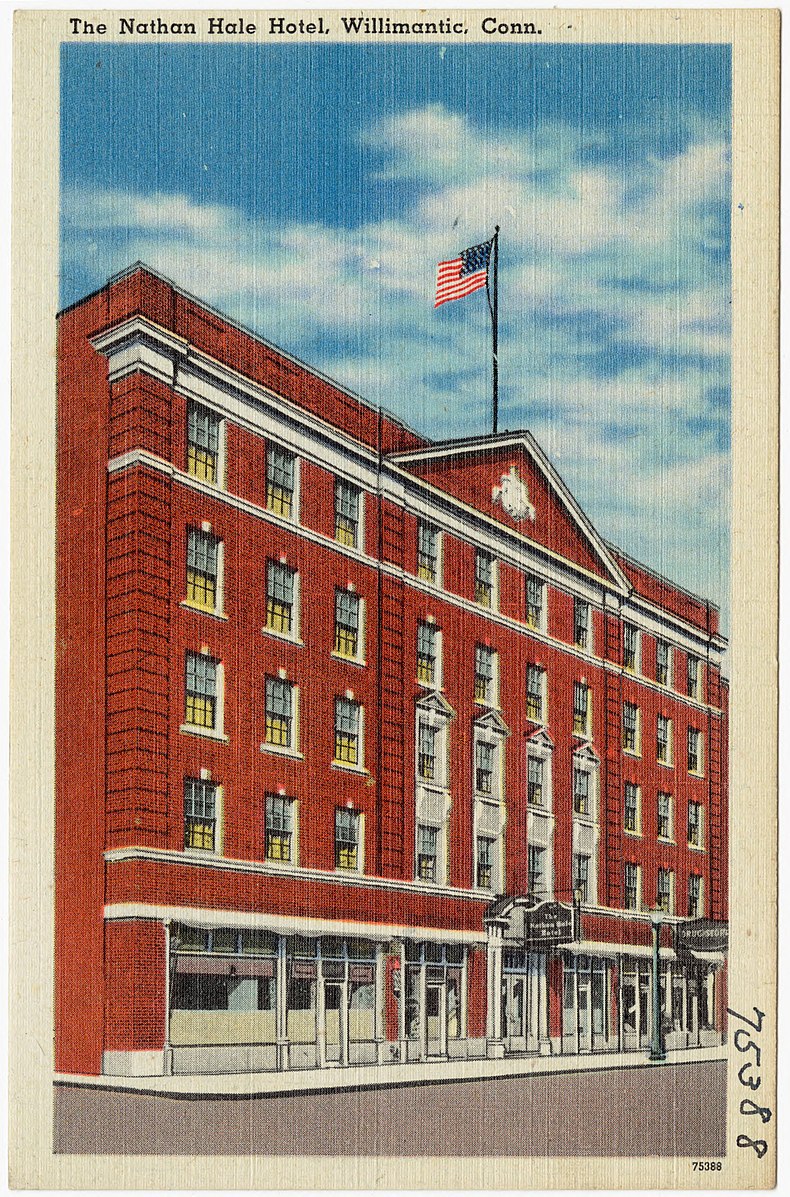
Battaglia/Corcoran/Rhodes and Simon: Adopting cheaper college learning materials
The formidable-looking Science Building at Eastern Connecticut State University, in Willimantic
From The New England Journal of Higher Education, a service of The New England Board of Higher Education (nebhe.org)
The 17-institution Connecticut State Colleges & Universities System (CSCU) formed a systemwide open educational resources (OER) Council in 2017 that was primarily focused on the adoption of no-cost or low-cost (NOLO) course materials as a means to provide equitable access to learning materials.
Our CSCU consortium of library directors partnered with the OER Council to construct a Web site, OpenCSCU, providing curated OER, a support network and a faculty-recognition program. The OER Council also has hosted annual OER workshops. Additionally, the CSCU system office funded a “mini-grant” program to further assist adoption. Much of the council’s focus and its connected OER efforts have been centered on equitable access to affordable learning materials. Over time, the council has expanded its focus to include open practices as a critical component to diversity, equity and inclusion in support of student success.
Even as we made strides in expanding the reach and focus of our OER efforts, the council recognized a communication gap persisted. The primary means of disseminating information from the council had been its representatives. We recognized that our institutions may have been at varying levels of engagement with OER and that our council representatives may have had competing priorities. It became clear that to better serve our institutions we needed to create a centralized communication channel to provide broader engagement and reach. Enter the blog.
With the OpenCSCU site established as a clearinghouse for OER-related information, it was a natural progression to take advantage of the existing technology for this new communications effort. Recognizing the limitations of our previous communications methods, which relied heavily on email, the council sought to better utilize the OpenCSCU Web site feature set. The website runs off the Springshare LibGuides platform and provides a blog option that is flexible and visually appealing. Creating posts with persistent URLs (such as “/blog” vs. system-generated code) and a consistent location would allow us to easily disseminate up-to-date content more widely beyond the confines of email, such as through social media channels and other means of link sharing.
The CSCU OER Council formed a task force to explore how the blog could support the council’s goals of broader dissemination of open practices, recognizing the work of practitioners and advocates and growing the open community.
Creating the blog
As the task force began its work, we felt compelled to establish guiding principles for this initiative. We wanted our OER efforts to be deeply rooted in equity as well as community members’ innovations and successes. A consistent piece of feedback we had received from our previous efforts was a call for more perspectives from faculty and less from staff and administration. (After all, our faculty are the primary audience.) As a result, we decided early on that our featured posts would focus on faculty practitioners and their application of open practices and principles within their courses but also would include perspectives of students, staff and administration.
The lengthiest discussions centered around determining editorial standards for the blog. The task force looked to established academic blogs for insights and inspiration. The New England Board for Higher Education and its New England Journal of Higher Education provided some invaluable guidance to help us move forward. The WICHE Cooperative for Educational Technologies (WCET) also shared documented standards for its long-running blog site, Frontiers.
As a result, our standards focused on acceptable content and tone, readability and accessibility, format, media usage, licensing and the editorial review process. As OER advocates, we emphasized the requirement of open licensing for submitted content.
The OER Council’s blog task force made a conscience decision to solicit selected authors versus issuing a broad call. Our intent was to recruit three to four innovative faculty to share their stories in Year One of launching this new initiative. This approach ensured that we had a full year of highly relevant content. In future years, we will be providing an online form for interested individuals to submit proposals.
In determining the quarterly release schedule, we considered how our featured blog posts might correspond with national and regional events such as the Open Ed Conference, Open Ed Week, and the Northeast OER Summit, to coincide with heightened interest in OER. In addition to our invited authors, we agreed that we would supplement the quarterly features with timely and relevant news and events, spotlighting professional development and grant opportunities
The future of the blog
On Sept. 21, the OpenCSCU Blog was launched. Its featured post was entitled “Presenting and Promoting Open Pedagogy Through Different Frameworks” by Nicolas Simon, an assistant professor at Eastern Connecticut State University who was joined by three of his students: Tara Nguyen, Jean Rienzo and Maya Vanderberg. With feedback still coming in, the editorial board has shifted to planning the next featured post and identifying newsworthy items to share in the interim.
We plan to present practical examples that can be replicated by others, including an in-depth look at open pedagogy, regaining intellectual property rights, and publishing an open text. Looking beyond the next scheduled releases, the editorial board in conjunction with the full OER Council have started to explore the next steps for the blog. In the short term, the editorial board will establish and publish criteria for selection. In the long term, we will explore how the blog can facilitate two-way conversations.
Overall, we intend to provide guidance and support to readers by demonstrating the value of open content and practices to better serve student success. As we share more content, we hope that our reader base will grow and that our blog posts will encourage conversation and innovation in open education. We hope to generate broader awareness of open practices and build a community of practice that not only validates and normalizes open pedagogy, but also inspires new efforts.
Hayley Battaglia is the serials & electronic resources librarian at Hilton C. Buley Library of Southern Connecticut State University. She is a member of the CSCU OER Advisory Council, chair of the OER Committee at Buley Library, a graduate of the Creative Commons Certificate Course and editor of the OpenCSCU Blog.
Kevin Corcoran is the executive director for digital learning at the Connecticut State Colleges & Universities System. He currently chairs the CSCU OER Advisory Council and the statewide Connecticut OER Coordinating Council and serves on the NEBHE OER Advisory Board.
Eileen Rhodes currently serves as the interim director of the Connecticut State Community College Library. Prior to this, she served as director of library services at Capital Community College in Hartford, Conn., for more than seven years. She is an OER advocate, initiating a “NOLO” labeling program at her college to identify courses with no-cost/low-cost course materials.
Nicolas P. Simon is an assistant professor of sociology at Eastern Connecticut State University. The supplemental works co-authored with his students have been featured in Introduction to Sociology, third edition, published by OpenStax.
Proudly sing of the 'Willimantick'
The Willimantic River flows past the site of the old American Thread Company mill, in Willimantic, Conn.
“We dare not be original; our American Pine must be cut to the trim pattern of the English Yew, though the Pine bleed at every clip. This poet tunes his lyre at the harp of Goethe, Milton, Pope, or Tennyson. His songs might better be sung on the Rhine than the Kennebec. They are not American in form or feeling; they have not the breath of our air; the smell of our ground is not in them. Hence our poet seems cold and poor. He loves the old mythology; talks about Pluto—the Greek devil,—— the Fates and Furies—witches of old time in Greece,—-but would blush to use our mythology, or breathe the name in verse of our Devil, or our own Witches, lest he should be thought to believe what he wrote. The mother and sisters, who with many a pinch and pain sent the hopeful boy to college, must turn over the Classical Dictionary before they can find out what the youth would be at in his rhymes. Our Poet is not deep enough to see that Aphrodite came from the ordinary waters, that Homer only hitched into rhythm and furnished the accomplishment of verse to street talk, nursery tales, and old men’s gossip, in the Ionian towns; he thinks what is common is unclean. So he sings of Corinth and Athens, which he never saw, but has not a word to say of Boston, and Fall River, and Baltimore, and New York, which are just as meet for song. He raves of Thermopylae and
Marathon, with never a word for Lexington and Bunker Hill, for Cowpens, and Lundy’s Lane, and Bemis’s Heights. He loves to tell of “smooth sliding Mincius, crowned with vocal reeds,” yet sings not of the Petapsco, the Susquehannah, the Aroostook, and the Willimantick. He prates of the narcissus, and the daisy, never of American dandelions and bue-eyed grass; he dwells on the lark and the nightingale, but has not a thought for the brown thrasher and the bobolink, who every morning in June rain down such showers of melody on his affected head. What a lesson Burns teaches us addressing his “rough bur thistle,” his daisy, “wee crimson tippit thing,” and finding marvellous poetry in the mouse whose nest his plough turned over! Nay, how beautifully has even our sweet Poet sung of our own Green river, our waterfowl, of the blue and fringed gentian, the glory of autumnal days.”
― Massachusetts Quarterly Review, 1849
Those old 'railroad hotels'
Above, the Nathan Hale Hotel in Willimantic, Conn., in better days. Below, the Hooker Hotel in recent dark days.
TFrom Robert Whitcomb’s “Digital Diary,’’ in GoLocal24.com
The New England News Collaborative (NENC), a consortium of NPR stations, has a nice piece on its Web site about efforts to fix up that old textile mill town of Willimantic, Conn. (which called itself “The Thread City’’).
Much of the story focused on whether to tear down two old abandoned and adjacent Main Street hotels. One is the Nathan Hale Hotel, built in the Twenties and named after the Connecticut man who became a soldier and spy in the Revolutionary War and was executed by the British for his brave work. (He’s the official “State Hero’’ of Connecticut.) The other is the unfortunately named Hooker Hotel built in 1887 (where in some of its later years some women of that age-old profession were known to ply their wares). In fact, the building is named for the respectable Seth Chauncey Hooker, its developer.
Both the hotels were what used to be called “railroad hotels’’. They were close to the train stations in their towns or cities and were heavily used by salesmen, such as Willy Loman, the sad protagonist of the play Death of a Salesman.
Most of these hotels have long since disappeared with the demise of rail passenger service to many towns and even cities and its replacement, by car travel, aided and abetted by the Interstate Highway System. The rise of car culture led to most hotels and motels being built away from downtowns, on suburban shopping strips and/or close to the nearest Interstate – with lots of parking.
Marriotts and other chains, etc., can be very nice but I miss the quirky atmosphere of these old downtown hotels in New England, where local luminaries and others would gather, often almost every day, to eat in their dining rooms (Yankee pot roast! Finnan haddie!) and attend meetings of local civic organizations. Their lobbies were almost like town halls.
To read and hear the NENC’s piece, please hit this link:
https://nenc.news/historic-willimantic-connecticut-to-demolish-rough-reputation





